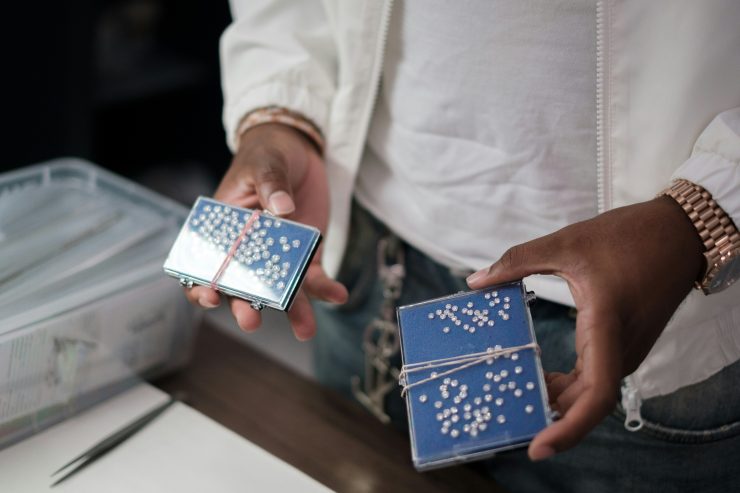Before entering any negotiation regarding natural diamond purchases, it is essential for buyers to understand how diamond pricing works in general. Natural diamond prices are influenced by the classic “4 Cs” — carat weight, cut, color, and clarity — but these are only part of the equation. Global market demand, supply chain costs, and even geopolitical factors can also influence pricing. For instance, diamonds sourced from regions with political instability may carry different pricing implications than those from countries with more regulated mining operations. Additionally, the Rapaport Diamond Report (commonly known as the Rap Sheet) serves as a general benchmark for wholesale pricing and is often used by industry professionals. Buyers who familiarize themselves with this guide can gain better insight into the baseline prices for various types of diamonds, allowing them to make more informed offers and challenge inflated retail markups effectively.

Researching Retailers and Comparing Offers
Not all diamond retailers offer the same pricing structures or service levels. High-end jewelry boutiques may charge premium prices due to their brand name, ambiance, and added services such as lifetime warranties or customization options. On the other hand, independent jewelers or online platforms may offer the same diamond quality for significantly less. This price difference underscores the importance of comparison shopping before engaging in any negotiations. By obtaining written quotes from multiple vendors, buyers gain leverage in their negotiations, especially when a competitor’s lower price can be used to request a price match or better offer. It is also worthwhile to check whether the retailer belongs to professional organizations such as the Jewelers of America or the American Gem Society, as these affiliations may reflect a commitment to ethical practices and transparent pricing, further aiding your negotiation strategy.
Mastering the Art of the 4 Cs in Negotiation
Understanding the 4 Cs — carat, cut, color, and clarity — is more than just a way to select a diamond; it’s a strategic tool during negotiation. Each of these attributes can significantly affect the price of a diamond, and buyers who are flexible on one or more of these characteristics may be able to reduce costs without sacrificing overall visual quality. For example, opting for a diamond just under a full carat (such as 0.95 instead of 1.00) can yield a substantial price break while maintaining near-identical appearance. Similarly, prioritizing excellent cut quality over absolute clarity or color can maximize brilliance and aesthetic appeal at a more affordable price. By strategically selecting which characteristics matter most and which ones can be compromised, buyers create room for negotiation while maintaining satisfaction with their purchase. Retailers are often more willing to offer discounts or upgrades when buyers demonstrate in-depth knowledge of these grading aspects.
Building a Relationship with the Seller
Negotiating effectively is not only about presenting hard facts and competitive offers; it’s also about establishing rapport with the seller. Sales associates and jewelers are often more inclined to provide discounts, extended payment plans, or added services when they feel a genuine connection with the customer. Engaging respectfully, asking thoughtful questions, and expressing serious intent to buy can transform a standard transactional interaction into a collaborative dialogue. Buyers should avoid aggressive haggling tactics that could alienate the seller. Instead, expressing appreciation for the seller’s expertise and showing interest in their inventory while subtly inquiring about discounts, bundle deals, or promotions can be far more effective. In many cases, sellers will offer concessions such as reduced pricing, complimentary appraisals, or upgraded settings as goodwill gestures, especially if the buyer is perceived as informed, polite, and likely to return for future purchases.
Knowing When and How to Make an Offer
Timing plays a critical role in price negotiations. Buyers who walk into a jewelry store during slow business periods — such as weekdays or off-peak seasons like late summer — may find sellers more receptive to negotiation. Additionally, promotions around major holidays or engagement seasons (like Christmas or Valentine’s Day) often come with competitive pricing that can serve as a useful baseline for further negotiation. When making an offer, it is important to be reasonable but firm. Offers that are too low may be dismissed outright, while slightly discounted but justifiable offers can lead to fruitful discussions. For example, offering 10% below the listed price while referencing comparable diamonds elsewhere and emphasizing readiness to purchase on the spot may yield results. Always ask if there’s flexibility in the price or if there are any current promotions you may not be aware of. Many retailers have discretionary pricing leeway and may offer better deals simply when asked.

Leveraging Certification and Appraisal Reports
One of the most effective tools a buyer can use during negotiation is a third-party diamond certification. Reputable grading labs such as GIA (Gemological Institute of America) or AGS (American Gem Society) provide objective assessments of a diamond’s attributes. Buyers should always request to see a diamond’s certification before committing to a purchase. Not only does this confirm the authenticity and quality of the diamond, but it also allows buyers to compare similar diamonds across different sellers more accurately. Additionally, requesting an independent appraisal — ideally from a qualified gemologist not affiliated with the seller — can reveal discrepancies between asking price and actual market value. If the appraisal comes in lower than the sale price, this can serve as strong leverage for negotiation. Conversely, if the seller refuses to provide certification or discourages third-party appraisals, this can be a red flag. Armed with professional documentation, buyers can approach negotiations with far greater confidence and authority.
Exploring Hidden Costs and Added Value
While focusing on the base price of a diamond is important, buyers should also consider hidden costs and value-added features when negotiating. These may include taxes, setting charges, resizing fees, appraisal documentation, and insurance add-ons. Sometimes a seller may not budge on the stone’s price but might be willing to waive or reduce these ancillary expenses. Alternatively, a seller may be open to adding complimentary services such as a free cleaning plan, future trade-in guarantees, or a more premium ring setting at no additional cost. These extras can amount to significant savings over time and should be factored into the negotiation strategy. Buyers should request a full breakdown of the total cost and inquire whether any part of it is flexible. Understanding which elements of the deal can be negotiated beyond just the diamond’s base price gives buyers additional avenues to maximize value and walk away feeling satisfied with the overall transaction.
Utilizing Online Retailers and Auctions
In the modern diamond market, online platforms play an increasingly significant role and can serve as powerful leverage points during in-person negotiations. Websites such as Blue Nile, James Allen, and Whiteflash offer detailed inventories with high-resolution images, virtual try-on tools, and certified grading reports. Buyers who research prices online beforehand can reference comparable listings when negotiating with brick-and-mortar sellers. Some retailers may even offer price matching against reputable online vendors to secure a sale. Auction platforms and estate sales are another potential source of competitively priced natural diamonds. While buying from these venues requires more due diligence — particularly around certification and return policies — the prices are often significantly lower than traditional retail. Even if a buyer does not intend to purchase online, the availability of lower online pricing arms them with a persuasive argument for negotiating better terms with local jewelers who may otherwise mark up their merchandise for in-store presentation and service.
Avoiding Common Pitfalls in Diamond Negotiation
Negotiating the price of a natural diamond is a delicate process that can be undermined by common mistakes. One such error is negotiating emotionally rather than strategically. For instance, becoming overly attached to a specific stone may reduce a buyer’s willingness to walk away or push for a better price. Another pitfall is failing to research sufficiently or relying solely on the seller’s advice without independent verification. Buyers should also avoid assuming that bigger is always better. A smaller diamond with exceptional cut and sparkle may provide greater satisfaction than a larger stone with lower visual appeal. Additionally, buyers should beware of high-pressure sales tactics such as “limited-time offers” or “this stone will be gone tomorrow” lines. Such strategies are designed to induce impulsive decisions. Instead, buyers should take their time, request written quotes, and feel free to walk away if the deal does not meet their expectations. Patience and preparedness are critical to successful diamond negotiations.
Finalizing the Purchase with Confidence
Once a favorable price has been negotiated, buyers should take several final steps to ensure they are making a secure and informed purchase. First, request all details of the sale in writing, including the diamond’s specifications, certification number, agreed-upon price, and any included services or guarantees. Review the return and exchange policies carefully, as a reputable seller should offer a reasonable grace period for returns in case of dissatisfaction. Buyers may also want to consider purchasing insurance immediately after buying the diamond to protect against loss, theft, or damage. If the diamond is being set in a ring or other jewelry, ask for a final inspection before and after the setting process to ensure no damage occurred. By closing the transaction methodically and confirming all aspects of the agreement, buyers can enjoy peace of mind, knowing they made a smart investment and secured the best possible deal through informed and strategic negotiation.